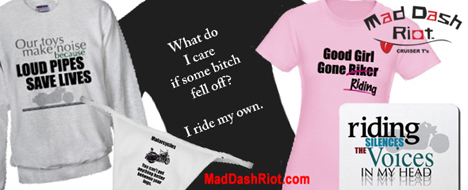Motorcycle Training Part 2: Before You Get On The Road
by Linda Carruth
Once you have taken all the steps towards learning to ride a motorcycle, there are some things to consider before actually getting on the road.
First, make sure you are familiar with your state’s laws regarding motorcycles. Learner’s permits often have certain restrictions that prohibit carrying a passenger, riding after dark, riding on the freeway, or even whether or not you must wear a helmet. Even with a motorcycle endorsement, you may be considered a novice for a period of time and that may carry its own restrictions.
In addition, there may be restrictions regarding the equipment on your motorcycle. There are many aftermarket products, such as brake lights with chasers, that are illegal in some states. Make sure a bike addition is legal before you purchase and install it on your ride.
Second, invest in protective gear. Leather and Kevlar are durable materials that can help protect you in a fall. Leather is also very good at blocking the wind and keeping out the cold. The wind tends to go right through woven or knit fabrics, even microknits and fleece. Consider purchasing leather chaps for leg protection as well, and at the very least, wear long pants, if only to prevent burning your legs on hot engine parts. Holding your knees out to the side to prevent burning bare legs is not a safe way to ride as it decreases stability.
Here’s a quick test for riding temperature. When you’re driving in your car (with no oncoming traffic), roll the window down, stick your arm out, and leave it there. That’s what your whole body will feel like when riding. Dress for it. Hypothermia and dehydration ramp up fast when riding a motorcycle. So dress for the weather and drink plenty of water.
Get a rain suit and keep it in your saddlebags at all times. As soon as you don’t have it with you, you’ll need it. Consider the weather changes for the day and how long you’ll be out. Longer rides can easily require many changes of gear, from morning to mid-day to evening and after dark. Be prepared.
Sturdy riding boots that cover the ankle and have a good grip on the bottom are essential. Cloth tennis shoes or flip flops (even with floor boards) provide no stability and can come off the feet, causing an accident. Is it worth it?
Consider a helmet; some states still require them but more and more states are repealing their helmet laws. (If you’re planning an out of state ride, check with all the states you’ll be riding through, to see if they have helmets laws. This is often overlooked.) Accidents involving riders without helmets are more likely to result in fatalities, plain and simple. Motorcycle fatalities are on the rise, and to date, this has been attributed to fewer riders wearing helmets AND the fact that there are more riders on the road now. If your state affords you that choice, make it carefully. It’s your life and your loved ones who may suffer consequences, not the state.
Fingered leather gloves are highly recommended although many riders choose not to wear them, especially in warmer weather. There are several schools of thought on this. One is that if you go down, the first thing you’ll put down to break your fall is your hands. Why not have a layer of something durable on them to tear through first, before some skin is ground off. Second, gloves provide a better grip of the controls. This is especially true with smaller hands or shorter fingers, as it helps provide the initial grip on the clutch and brake levers if they are a bit out of reach.
Third, do a pre-ride check of your motorcycle. If you took a Basic Rider Course, you are already familiar with this concept. In fact, there is an acronym, T-CLOCK, that helps you remember what to inspect before each ride. The T stands for tires and wheels, including air pressure, signs of wear, bulges, or embedded objects like nails. The C stands for controls, such as levers, cables, hoses, and throttle. The L stands for lights, and this includes headlamps, running lights, brake light, turn signals and battery. The O stands for oil and fluids, including oil, coolant, hydraulic fluid, checking their levels and inspecting for leaks. The C stands for chassis. These include your forks, swingarm, chain, sprockets, and cotter pins. Lastly, the K stands for kickstand. Make sure it is not bent or cracked, and check the spring tension. You can find more comprehensive information at the MSF website. The MSF website has a wealth of information about safety and riding, and it’s free.
Fourth, are YOU ready to ride? Make sure you are well rested and well fed before hitting the road. You need to be in tiptop shape so that you can be fully alert and ready to make split second decisions while riding. Your life or someone else’s may depend on it. This should go without saying, but remember, drinking and riding do not mix. Same goes for drugs, even many over-the-counter preparations. Know how something will affect you after ingesting it BEFORE you get on that bike. Riding from one bar to another is a far too common practice. Not smart!
So there you have it. If you take these things into consideration before rolling out of the driveway on your motorcycle, you’ve taken some good steps toward lessening the most common risks of riding a motorcycle. Ride safe and have fun.
Category: Motorcycle Savvy


